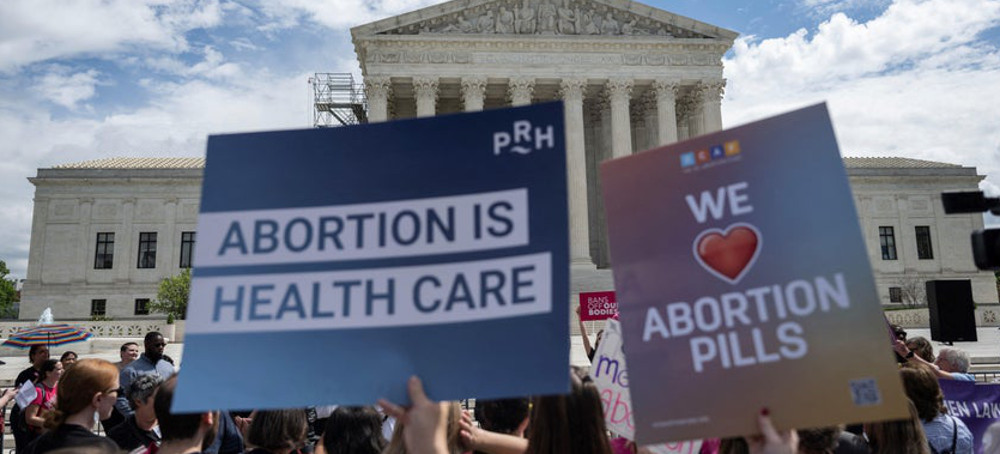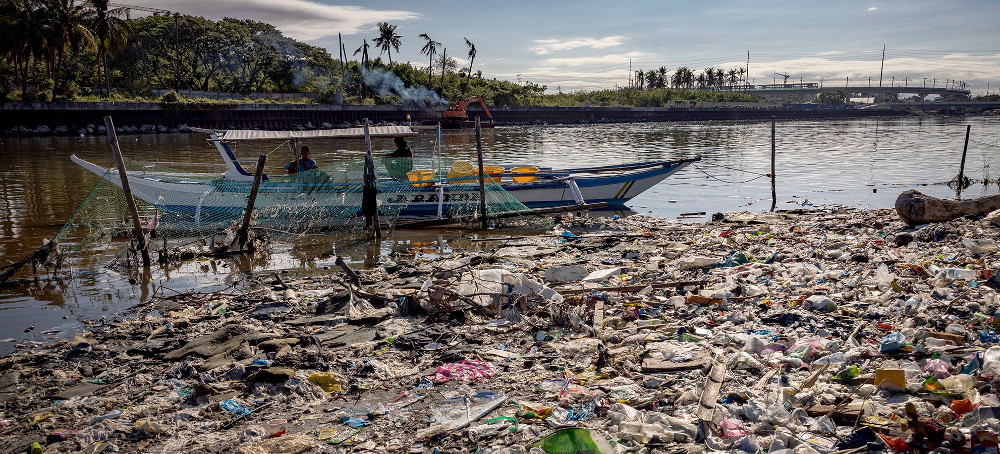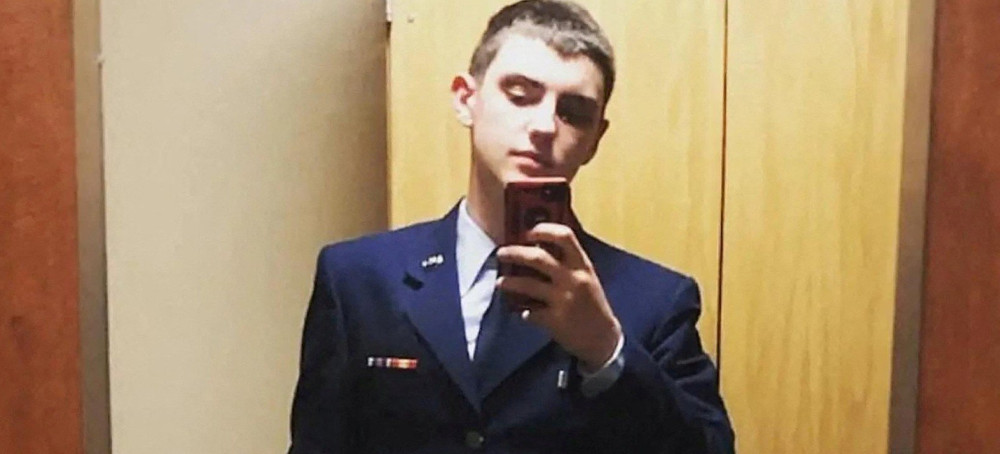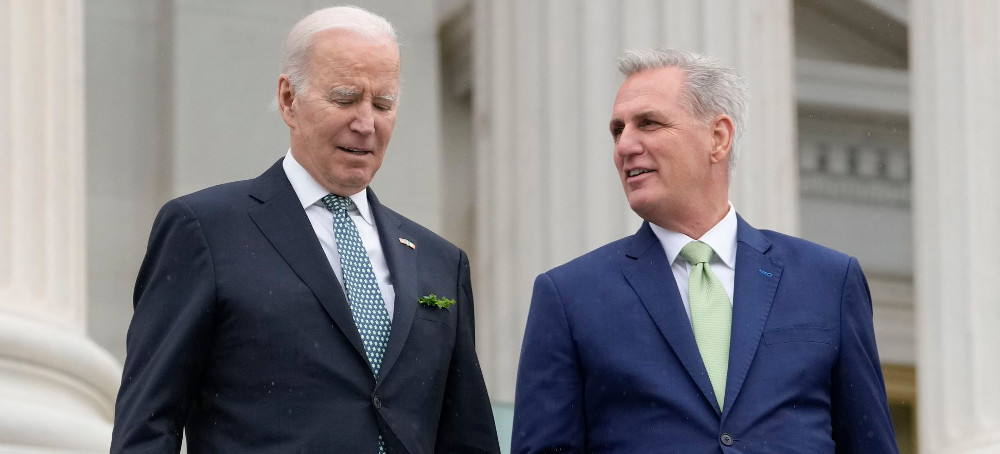Live on the homepage now!
Reader Supported News
More and more, however, it looks as if there never was a strategy beyond wishful thinking. I hope that I’m wrong about this — that President Biden will, at the last minute, unveil an effective counter to G.O.P. blackmail. He may even be forced to do so, as I’ll explain in a bit. But right now I have a sick feeling about all of this. What were they thinking? How can they have been caught so off-guard by something that everyone who’s paying attention saw coming?
For those somehow new to this, the United States has a weird and dysfunctional system in which Congress enacts legislation that determines federal spending and revenue, but then, if this legislation leads to a budget deficit, must vote a second time to authorize borrowing to cover the deficit. If even one house of Congress refuses to raise the debt limit, the U.S. government will go into default, with possibly catastrophic financial and economic effects.
This weird aspect of budgeting allows a party that is sufficiently ruthless, sufficiently indifferent to the havoc it might wreak, to attempt to impose through extortion policies it would never be able to enact through the normal legislative process.
What, then, should Biden … Co. have done once Republicans took the House? They could have tried to raise the debt ceiling during the lame-duck session. This would have been hard given an evenly divided Senate. If it was possible at all, it probably would have required making big concessions to those Democratic senators least supportive of Biden’s agenda. Still, better to have a hostage negotiation with Joe Manchin than with Marjorie Taylor Greene.
So unless there was a plan to deal with the coming confrontation, there should have been a major effort to raise the debt ceiling. The fact that there was no such effort suggested that maybe there was such a plan.
But all we’ve seen from Biden officials since the House changed hands has been a combination of assertions that a U.S. default would be catastrophic — which may well be true — and denigration of any and all possible end runs around the debt ceiling. My heart sank, for example, when Janet Yellen, the Treasury secretary, repeatedly rejected the idea of minting a platinum coin — one of several possible ways to bypass the debt limit — as a “gimmick.” Yes, it would be a gimmick, but it would also be harmless. As I explained the other day, it would not mean printing money to cover the deficit; in practice, it would amount to carrying out normal borrowing through a back door.
The problem is that Yellen was in effect saying that the administration wasn’t open to any strategies that sounded silly or unorthodox; yet every strategy that avoids the debt limit must, in fact, be unorthodox, and will probably sound silly if taken out of context.
The economic merits of various unconventional financing strategies aside, think about how the White House was positioning itself politically. On one side, it signaled that it was terrified of the consequences of default; on the other, it made it clear that it was unwilling even to consider any alternatives to an increase in the debt limit. The administration might as well have put a sign on its back saying “Kick Me.”
Maybe the administration expected moderate Republicans or business groups or supposedly nonpartisan advocacy groups to somehow step in and pressure the G.O.P. to produce a clean debt ceiling bill. But I don’t see how anyone who has been awake for the past 15 years could have believed that was a real possibility.
And sure enough, after months of asserting that it would never engage in negotiations over the debt ceiling, that it would accept nothing less than a clean increase, the administration is now … negotiating over the debt ceiling.
Many people have pointed out that this sets a terrible precedent, that having seen that extortion works, Republicans will engage in it again and again. Even these concerns, however, seem to me to be taking too long a view. Now that Republicans see what seems to be an administration on the run, there’s every reason to expect them to keep escalating their immediate demands — quite possibly to the point where no deal is possible.
There’s a precedent from the Obama years. Back in 2011, President Obama and John Boehner, who was then the speaker of the House, came very close to a so-called Grand Bargain on debt that would have been objectively terrible — it would, for example, have raised the age of eligibility for Medicare, even though life expectancy for working-class Americans had risen very little — and would probably have been politically disastrous for Democrats. But the deal fell through because Republicans were unwilling to accept even small tax increases as part of a deficit-reduction plan.
Sure enough, Republicans have reportedly rejected every proposal to make a debt ceiling deal more acceptable to the Democratic base by closing tax loopholes.
I have no idea what happens next. I think there’s a real possibility that Biden officials will in the end be forced by sheer Republican intransigence to adopt unconventional methods after all — a task that will be made much harder by the fact that those same officials have spent months trash-talking the approaches they may need to follow.
But I don’t see any way to regard this whole episode as anything but a disastrous failure to face up to the reality of an opposition party controlled by extremists.
READ MORE  Demonstrators rally in support of abortion rights at the U.S. Supreme Court on April 15. (photo: AFP)
Demonstrators rally in support of abortion rights at the U.S. Supreme Court on April 15. (photo: AFP)
And here’s the punchline: Nothing these intellectual Lilliputians do will even matter. The Supreme Court has already decided that the 5th Circuit cannot be trusted with this case: In April, it froze the court’s previous decision stringently limiting access to mifepristone, expressly maintaining the freeze until the justices themselves take further action. Elrod, Ho, and Wilson are howling into the wind; they have no power to change a thing about federal regulation of medication abortion. The adults in the room have already put them in time-out. And rather than demonstrate that they can judge responsibly, they seized on Wednesday’s hearing to throw a combination temper tantrum/gaslight party. No lessons have been learned, no maturity acquired. This time-out probably isn’t ending anytime soon.
It would be cruel and unusual to subject the reader to a full recap of this sorry case, but here are the basics: In 2000, after a four-year review, the FDA approved mifepristone, in combination with misoprostol, for medication abortion. The agency imposed stringent limits on the drug and studied it extensively, eventually finding that it is incredibly safe and effective. In response to these findings, the FDA has reduced barriers to mifepristone since 2016: It authorized the drug’s use until 10 weeks of pregnancy (up from seven), approved a generic version, reduced reporting requirements, and stopped mandating three in-person doctor visits.
After the Supreme Court overturned Roe v. Wade, a group of anti-abortion activists created a group called Alliance for Hippocratic Medicine for the purpose of suing over mifepristone. They incorporated AHP in Amarillo, Texas, so that Judge Matthew Kacsmaryk—a former anti-abortion advocate known for extreme, dangerous, and incoherent far-right rulings—would be guaranteed to hear the case due to a jurisdictional loophole. Then they sued, represented by the Christian nationalist hate group Alliance Defending Freedom. Kacsmaryk played his part, issuing an unprecedented and unhinged decision purporting to suspend the FDA’s 23-year-old approval of mifepristone. The 5th Circuit futzed with his decision in a hopeless effort to make it marginally more plausible, but the Supreme Court didn’t bite: With only two dissenting votes, SCOTUS stayed Kacsmaryk’s whole ruling, meaning that nothing he or the 5th Circuit does to attack the drug will have any legal effect, unless the Supreme Court does an about-face and ultimately sides with the 5th Circuit.
Which brings us to Wednesday, when the FDA and Danco Laboratories (which manufacturers mifepristone) tried to pull the 5th Circuit back into the orbit of reality. It was a futile exercise. Elrod, a George W. Bush appointee, is one of the most disingenuous and petty judges on the bench. Ho is an extremist and a troll who’s blotto on his own power. Wilson, for his part, often seems to misunderstand basic facts about any given case. Both Ho and Wilson are—drum roll, please—Trump appointees. Sarah Harrington (for the FDA) and Jessica Ellsworth (for Danco) did an amazing job handling a comically hostile bench. But what was the point? Nobody seriously expects these robed ideologues to do their job with a modicum of integrity. Here are a few lowlights of the hearing:
•Ho credulously repeated the plaintiffs’ false claim that the FDA smuggled through mifepristone by calling pregnancy a “life-threatening illness.” (This argument rests on the lie that mifepristone went through “expedited review,” which Ho also parroted.) He asked Harrington angrily: “When we celebrated Mother’s Day, did we celebrate an illness?”
•Elrod, with evident exasperation, castigated the FDA for failing to produce a complete administrative record for the case—which, as Harrington explained, would require lawyers to compile for the court “hundreds of thousands of pages” going back to the 1990s. In response, Elrod suggested that the government was unscrupulously keeping it “a secret.”
•Wilson asserted that, by allowing medical professionals other than doctors to prescribe mifepristone, the FDA made it “much more likely” that patients will need emergency care, including surgery. (He literally just made this up.)
•Elrod suggested that Danco Laboratories should spend countless hours and resources to prepare for a judicial imposition of draconian restrictions on mifepristone just in case the court chose to do so, dismissing any costs as a minor “inconvenience.” (This, of course, completely ignored the Supreme Court’s order, which freed the defendants from this very obligation.) She also suggested, without evidence, that Danco may be complicit in smuggling the pills into states where they are banned.
•Ho read aloud random people’s criticisms of the FDA and made Ellsworth respond to them, then declared that federal courts should override the FDA’s scientific determinations because the agency isn’t trustworthy.
•Elrod chastised Ellsworth for calling Kascmaryk’s decision an “unprecedented judicial assault” in her brief, calling the rhetoric “far outside the bounds of established [criticism]” and a “personal attack” on Kacsmaryk. She then asked Ellsworth to retract the statements and apologize.
These are not serious people. This is not how real judges conduct themselves. This was barely a judicial proceeding. It was a struggle session in which three anti-abortion zealots yelled at attorneys who have already prevailed in this case once at the Supreme Court. Their rage should have been aimed at SCOTUS, but it’s not a good look for lower courts to trash-talk their superiors, so they redirected it to Harrington and Ellsworth instead. (Erin Hawley, wife of Sen. Josh Hawley, argued against mifepristone; the less said about her unceasing stream of shameless falsehoods, the better.)
It’s sad, really, what has happened to the 5th Circuit. In the civil rights era, this court led the charge for desegregation, fighting massive resistance with forceful decisions that helped break the back of Jim Crow. And today? Today it is the laughingstock of the judiciary; even other conservative judges—including some of the Supreme Court—refuse to follow its march into the abyss. Wednesday painfully reminded us why.
READ MORE  Erdogan led the polls with 49.5 percent of the vote with Kilicdaroglu bagging 44.89 percent. (photo: Stoyan Nenov/Reuters)
Erdogan led the polls with 49.5 percent of the vote with Kilicdaroglu bagging 44.89 percent. (photo: Stoyan Nenov/Reuters)
The CHP and YSP have voiced concerns and lodged complaints since Sunday about the discrepancies between recorded count made at polling stations and the votes entered into the Supreme Election Council’s system.
The Cumhuriyet Halk (Republican People’s Party, CHP) and the Yeşil Sol Party (Green Left Party, YSP) have voiced concerns and lodged complaints since Sunday about the discrepancies between recorded count made at polling stations and the votes entered into the Supreme Election Council’s (YSK) system.
On Wednesday, Muharrem Erkek, CHP’s deputy chair, said irregularities were found by the party in 7,094 ballot boxes after it checked more than 201,000 from within Turkey and abroad.
Some 4,825 of the CHP’s objections were over parliamentary votes and 2,269 in the presidential election.
Complaints over election irregularities are a common event during Turkish elections, and observers have pointed out that many of the discrepancies during Sunday’s vote may have been the result of errors in the CHP’s own system, rather than the YSK’s.
Turkey’s presidential election will head to a run-off on May 28 after neither the incumbent Recep Tayyip Erdogan, nor CHP leader Kemal Kilicdaroglu managed to win an outright 50 percent majority on Sunday.
Erdogan led the polls with 49.5 percent of the vote with Kilicdaroglu bagging 44.89 percent.
Erkek said votes for Kilicdaroglu had been incorrectly allocated to Muharrem Ince who pulled out of the presidential race three days before the election, not allowing enough time to print new ballot papers without his name.
Speaking to journalists in Ankara on Wednesday, Erkek said extra votes were also given to Erdogan, without giving any evidence.
“We are following every single vote, even if it does not change the overall results,” Erkek said.
In the parliamentary polls, Erdogan’s Adalet ve Kalkınma Party (Justice and Development Party, AK Party) took the most ballots.
The Milliyetçi Hareket Party (Nationalist Movement Party, MHP), AK Party’s alliance party, outperformed expectations with more than 10 percent of the vote share.
The YSP, which fielded parliamentary candidates from the pro-Kurdish Halkların Demokratik Party (Peoples’ Democratic Party, HDP) due to a legal closure threat against the latter, said it had discovered more than 1,000 cases of incorrect entries.
“We have no evidence to say if there is an organised malignancy behind these mistakes and errors or whether someone is deliberately trying to influence these outcomes,” YSP’s election spokesperson Mehmet Rustu Tiryaki said on Tuesday.
The party backed Kilicdaroglu, who leads a six-party alliance, for the presidency.
Voting irregularities
On Monday, the AK Party pushed back against the CHP’s claims, with party spokesman Omer Celik accusing the opposition of pushing “false statements” and “false data”.
“As of yesterday [Sunday], everything they said was wrong,” Celik said. “As of yesterday, their approach of imposing their own data unilaterally by attacking others and presenting their own data as an absolute truth that everyone should accept has collapsed, but today they continue to act as if nothing has happened as usual.”
The election authority is due to publish its data on Friday. However, it has shared information on the votes with political parties.
The CHP told voters to check data published on YSK’s website against freely available polling station records. That led to people posting discrepancies on social media, including instances in Turkey’s Kurdish-majority southeast where HDP/YSP votes seemed to have been transferred to the MHP.
Although election campaigns in Turkey have been criticised for allowing the governing party an unfair advantage over its use of state resources, control of media and legal intimidation of opponents, the actual vote itself had been thought to be largely secure.
YSK President Ahmet Yener, however, condemned the claims made online as “unfounded” and “intended to mislead the public”, adding that the organisation’s system was “transparent”.
Roman Udot, co-chair of Golos, a Russian election data monitoring watchdog now based in Lithuania, said a study of YSK’s data of previous Turkish elections revealed “very strange things”.
“We found 3,500 polling stations where the turnout was more than 100 percent, over 800 percent in one case, which is mathematically impossible,” he told a news conference in Istanbul on Wednesday.
He added that data from the 2018 polls showed the number of registered voters in Ankara being 3 percent lower for the presidential race than the parliamentary vote.
On Tuesday night, a group of people holding a “democracy watch” outside the YSK’s Ankara offices were detained by police.
“It is obvious that the YSK is clearly unlawful and is trying to usurp the will of the people,” Ilay Eroglu, a protester, told local media.
“We will protect our votes and our will and we will not be a victim of the same unlawfulness once again.”
READ MORE  Changes needed are major but also practical and affordable, report says, and would bring trillions of dollars in benefits (photo: Reuters)
Changes needed are major but also practical and affordable, report says, and would bring trillions of dollars in benefits (photo: Reuters)
Changes needed are major but also practical and affordable, report says, and would bring trillions of dollars in benefits
The first step is to eliminate unnecessary plastics, such as excessive packaging, the report said. Then next steps are to increase the reuse of plastics, such as refillable bottles, boosting recycling and replace plastics with greener alternatives.
Such a shift, driven by government policies and changes in the plastic industry, would mean plastic pollution would drop to about 40m tons in 2040, rather than 227m tons if no action is taken.
The changes would bring benefits worth trillions of dollars between now and 2040, the report said, by reducing the damage caused by plastics to health, the climate and the environment.
Plastic now contaminates the entire planet, from the summit of Mount Everest to the deepest oceans. People consume microplastics via food and water, as well as breathing them in, and the particles have been found in people’s blood and breast milk.
In March 2022, 193 countries agreed to end plastic pollution, with negotiations on a legally binding agreement by 2024 now under way, hosted by Unep. The second round of negotiations starts on 29 May. The world currently produces 430m tons of plastics a year, two-thirds of which are short-lived products that soon become waste. Production is set to triple by 2060 on current trends.
“The way we produce, use and dispose of plastics is polluting ecosystems, creating risks for human health and destabilising the climate,” said Inger Andersen, Unep’s executive director. “This report lays out a roadmap to dramatically reduce these risks through adopting a circular approach that keeps plastics out of ecosystems, out of our bodies and in the economy.
“Crucially, the report demonstrates that the transformation would provide economic and social wins. Governments and the private sector would save money and hundreds of thousands of new jobs would be created,” she said.
The report estimated that the increased reuse of plastics could reduce 30% of plastic pollution by 2040, with measures including deposit-return schemes for containers. Such a scheme is due to start in England in 2025, seven years after it was first announced.
More recycling would cut pollution in 2040 by a further 20%, the report said. Taxing virgin plastic and removing fossil fuel subsidies are policies that would encourage this, by making recycling more economically attractive compared with producing new plastic. Enforcing packaging guidelines to increase the recyclability of products would also be important.
The careful replacement of plastic products, such as takeaway food containers, with alternative materials such as paper or compostable materials could cut another 17% from pollution in 2040, the report said.
Plastic items from takeaway food and drink dominate the litter in the world’s oceans, according to a 2021 study. There would still be a lot of plastic waste to be disposed of safely in 2040, and making manufacturers responsible for this would help, the Unep report said.
The report indicates that the combination of cost savings from producing less plastic and increased revenues from selling recycled plastic would reduce industry costs significantly. The investment needed for the overall shift would be substantial, at $65bn (£51bn) a year, the report said, but that is only about half of what is already invested by the plastic industry.
The UN report estimated that over the next 20 years, cutting plastic pollution by 80% would prevent damage valued at more than $3tn, including impacts on health, climate, air pollution, the ocean environment and legal costs for cases brought against plastic companies.
In particular, the 80% cut would prevent 500m tons of CO2 emissions per year, the report estimated, about the same as the emissions of Canada. This shift could also lead to a net increase of 700,000 jobs by 2040, mostly in low-income countries, the report said.
Andersen said the report was intended to inform the countries negotiating for a global plastic treaty of the options available. She said she was optimistic that a global deal could be reached in 2024: “There is a lot of determination from so many sides, north, west, east and south. [Ending plastic pollution] is a thing that people want as it is a problem wherever you are.
“There will still be a need for plastic,” she said. “But we need to rethink where we’re using it and how we’re using it, so that much more of it [is reused and recycled] and a lot less is merely single-use.”
READ MORE  A missile is seen in the sky over Kyiv. (photo: AFP)
A missile is seen in the sky over Kyiv. (photo: AFP)
The early morning duel in the sky over Kyiv between air defenses and missiles was the ninth attack on the capital this month, in what one Ukrainian official called an “unprecedented” string of strikes. The city was targeted with several cruise missiles, all of which were shot down by air defenses, local officials said.
Debris from an intercepted missile fell in one neighborhood of the capital and caused a fire, said Serhiy Popko, the city’s military administrator, in a post on social media. There were no immediate injuries, he said. The flurry of missiles were followed by reconnaissance drones deployed over the capital, he added.
READ MORE  This undated photo shows Jack Teixeira, a member of the Massachusetts Air National Guard accused of leaking U.S. national security information online. (photo: Reuters)
This undated photo shows Jack Teixeira, a member of the Massachusetts Air National Guard accused of leaking U.S. national security information online. (photo: Reuters)
The Justice Department, in a court filing ahead of Jack Teixeira’s next detention hearing, also says it found red flags in his Air Force record
Jack Teixeira, 21, was arrested in April after FBI agents traced back to him a collection of classified material posted in an online chat group. Authorities say Teixeira, who worked as an IT professional at a military base in Massachusetts’s Cape Cod, misused his top secret clearance to share U.S. intelligence assessments and other sensitive information with others on Discord, a social media platform popular with video game players.
He is scheduled to appear in court Friday where U.S. magistrate judge David Hennessy plans to rule on whether Teixeira should remain behind bars while awaiting trial. In their Wednesday court filing, prosecutors offered new evidence, “which compounds the national security and public safety risks that the government previously noted to the Court,” and shows, they said, that he should not be released.
One of the groups where he shared information had upward of 150 users, officials said, and among the members “are a number of individuals who represented that they resided in other countries” and whose accounts trace back to foreign internet addresses.
Teixeira’s “willful transmission of classified information over an extended period to more than 150 users worldwide” undermines his lawyer’s claims that he never meant for the information to be shared widely, prosecutors wrote.
Teixeira’s lawyer filed court papers arguing that prosecutors have wrongly compared his conduct to high-profile leak cases from the past, when the case is more similar to lesser-known leak investigations in which defendants were released on bond.
The new filing also recounts online chats in which Teixeira appears to both brag about how much classified information he knows and has shared, and understand the potential legal consequences of such actions.
“Knowing what happens more than pretty much anyone is cool,” the airman allegedly wrote in a chat dated mid-November. When another user suggested he write a blog about the information, Teixeira replied, “making a blog would be the equivalent of what chelsea manning did,” referring to a major classified leak case in 2010.
The filing also shows that Teixeira was written up by colleagues for apparently not following rules for the use of classified systems. A Sept. 15 Air Force memorandum included in the newly released court materials notes that Teixiera “had been observed taking notes on classified intelligence information” inside a room specifically designed to handle sensitive classified material.
Teixeira, the Air Force memo says, was instructed “to no longer take notes in any form on classified intelligence information.” About a month later, a memo noted that Teixeira “was potentially ignoring the cease-and-desist order” given to him in September. He was instructed to stop “any deep dives into classified intelligence information and focus on his job,” that memo said.
Then in January, a member of his unit observed Teixeira “viewing content that was not related to his primary duty and was related to the intelligence field.” That memo also noted that Teixeira “had been previously notified to focus on his own career duties and to not seek out intelligence products.”
A member of the Massachusetts Air National Guard, Teixeira has been charged with two counts: retention and transmission of national defense information and willful retention of classified documents. He faces up to 25 years in prison. As the investigation proceeds, he could face additional charges.
Prosecutors and defense lawyers had sparred over whether Teixeira should be released on bond. Federal prosecutors said he posed a security risk because he might still possess classified documents that investigators have not yet found, and foreign governments could try to recruit him to find out what he knows.
Teixeira’s lawyer, Brendan Kelley, has said that with careful monitoring Teixeira could safely go home — arguing authorities have tried to make a young man who still lives with his parents in the community where he grew up sound more dangerous than he is.
Hennessy, the judge, had pushed back on suggestions from Teixeira’s attorney, who claimed his client only meant to share the information with a small group of online friends, not the wider world.
“The defendant put top-secret information on the internet, and your argument is that he had no idea that it would go anywhere beyond the server,” Hennessy said at a hearing last month. “I find it a little incredible that the defendant could not foresee that possibility.”
Teixeira’s father told the court last month that, if his son were released, he would notify authorities should any bond conditions be violated, and that there would be security cameras around the home to alert the father to any movement there while he was at work.
“The damage the Defendant has already caused to the U.S. national security is immense. The damage the Defendant is still capable of causing is extraordinary,” prosecutors wrote in an earlier court filing. “Detention is necessary to ensure that the Defendant does not continue on his destructive and damaging path.”
In their filings, prosecutors have said Teixeira exhibited disturbing behavior five years ago while a high school student, and was suspended after a classmate overheard him talking about weapons, “including Molotov cocktails, guns at the school, and racial threats.”
More recently, according to prosecutors, Teixeira posted comments online about conducting a mass shooting, including in November when he wrote in a social media post that if he had his way, he would “kill a … [expletive] ton of people,” which he said would be “culling the weak minded.” In previous court filings, prosecutors also shared photos of what they characterized as an “arsenal” of weapons found in his home.
Teixeira’s lawyer has said the talk of an arsenal was overheated — because the guns in court images that had been thought to be in his room are not real weapons, but replicas known as airsoft guns. The firearms in Teixeira’s house are locked away in a cabinet, according to Kelley.
Prosecutors say there also is evidence that, as the leak investigation progressed, Teixeira may have destroyed evidence of his crimes and told others not to talk to authorities. Earlier this month, Teixeira allegedly told an online friend: “If anyone comes looking, don’t tell them” anything, and encouraged that person to “delete all messages.”
Teixeira’s attorneys have pushed back against those claims, saying Teixeira was peacefully reading a Bible when agents came to arrest him, and that prosecutors’ notions of the risks to national security if he is released are far-fetched and fanciful.
The prosecution, Teixeira’s lawyer Allen Franco wrote in a court filing last month, has engaged in “hyperbolic judgments and provides little more than speculation that a foreign adversary will seduce Mr. Teixeira and orchestrate his clandestine escape from the United States. This argument is illusory. The government has presented no articulable facts to support these assertions.”
READ MORE  The research could advance court cases seeking to hold polluters accountable for climate-fueled disasters. (photo: AP)
The research could advance court cases seeking to hold polluters accountable for climate-fueled disasters. (photo: AP)
The research could advance court cases seeking to hold polluters accountable for climate-fueled disasters.
The study, published in the peer-reviewed journal Environmental Research Letters on Tuesday, is the first to quantify how corporate emissions have made wildfires worse. Experts say the new research could help advance growing efforts to take polluters to court.
“These companies should be held accountable for their fair share of the damages that they’ve caused,” said Carly Phillips, a coauthor of the new study and a research scientist at the Science Hub for Climate Litigation at the Union of Concerned Scientists. “They lied and engaged in this orchestrated campaign of deception for years, and it didn’t have to be this way, right?”
Researchers from the Union of Concerned Scientists and the University of California, Merced, found that 37 percent of forest burned across the western United States and southwestern Canada since 1986 can be linked to carbon pollution from 88 of the world’s largest oil, gas, and coal companies. That group includes Chevron, ExxonMobil, BP, and Shell; state-owned oil producers like Saudi Aramco and Gazprom; and cement manufacturers. Researchers considered emissions directly emitted by these companies’ operations as well as the indirect emissions from the products they sold.
Since 2017, cities and states have filed around 20 lawsuits against fossil fuel companies based on state laws that prohibit deceptive advertising, seeking money to adapt to the effects of climate change. The suits were set in motion by investigations showing that Exxon, Shell, and coal companies had known about the dangers of skyrocketing carbon emissions for decades, but publicly downplayed the threat. After years of delays, the Supreme Court declined to get involved in these cases last month, clearing the way for them to proceed — potentially to jury trials.
The study comes as spring fires scorch western Canada during an unusually hot and dry spring, with about 1 million acres burning across the province of Alberta. An early heat wave pushed temperatures above 90 degrees in parts of the typically temperate Pacific Northwest over the weekend, with Seattle and Portland breaking heat records at least three days in a row. The same heat dome is expected to fan the flames of nearly 90 fires burning across Alberta.
It’s hard to draw a direct line between global warming and wildfires. But recent advances in “attribution science,” the field that identifies climate change’s role in heat waves, droughts, rising seas, and other phenomena, have made it possible to quantify its effect on fires. The new study relies on a key risk factor called the “vapor pressure deficit,” a measure of how “thirsty” the atmosphere is. Hotter temperatures cause moisture to be pulled out of vegetation, turning forests into tinderboxes just waiting for a spark.
To figure out how companies’ emissions contributed to fire-danger conditions in the West, researchers built on a previous study that linked emissions from 88 big fossil fuel producers to rising temperatures. Then they compared two models of how dry forests would be under different climate scenarios — one modeled on the real world, and the other excluding the emissions associated with the 88 companies.
“The major contribution of this study is to connect all of the dots between specific sources of human-related carbon emissions and recent increases in forest fire activity,” said Philip Higuera, a professor of fire ecology at the University of Montana who was not involved in the study. “Most of the links have been well known for a long time, but this is the first study to connect the dots, quantitatively.”
Exxon and BP did not respond to Grist’s request to comment in time for publication.
Jessica Wentz, a fellow at Columbia University’s Sabin Center for Climate Change Law, thought the findings could be used to support existing lawsuits, or provide the impetus for other local governments to file their own. Wentz said the research might be relevant to a case in Colorado, where the city and county of Boulder, along with San Miguel County, sued Suncor Energy and ExxonMobil, seeking millions of dollars to update their infrastructure to withstand climate change. “That’s the one lawsuit where wildfire-related damages are forefront and central,” Wentz said.
Translating the research to a specific court case could prove thorny, though. The study looked at a large region, the whole North American West, and the aggregate of 88 companies’ emissions. It’s possible that attorneys could use the new research to calculate wildfire risk over a smaller area — say, Boulder County — but it would require some extrapolation. For calculating damages, a court might want to see a more fine-grained analysis, Wentz said. “It’s really a totally open question of how courts will look at the evidence, and just how granular will plaintiffs need to be in terms of providing scientific data to support their claims. We just don’t know yet.”
In a way, the long delays in these climate court cases have actually given some ammunition to cities and states looking to hold fossil fuel companies accountable. The extra time has allowed the science of climate attribution to mature, so that if these cases end up going to trials, cities and states have more evidence to support their case. “It’s sort of a weird silver lining,” Wentz said.
Follow us on facebook and twitter!
PO Box 2043 / Citrus Heights, CA 95611



No comments:
Post a Comment
Note: Only a member of this blog may post a comment.